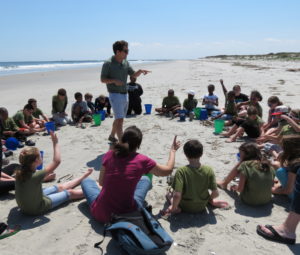A Watershed Year

To view the photo-rich magazine version, click here.
Originally appears in the Fall 2018 issue.
IT IS NO SURPRISE that children learn best by doing, and when they seamlessly integrate across subjects and spend ample time working to find solutions to real problems that will improve lives, fulfill needs, and make our world a better place, learning reaches a much deeper level. During my 16-plus years in a leadership role in experiential education, establishing partnerships and supporting hundreds of teachers and thousands of students in authentic learning, I witnessed this success first hand. There is also no doubt that if you want to get students truly excited about what they are learning, ask them to tackle a real-world question or problem — ask them to solve something that is relevant to their lives. In using this approach, students come to realize that what they are doing in school really does have meaning.
Whether describing this learning process with terminology such as STEM, STEAM, Project-Based Learning, Problem-Based Learning, or EIC (Environment as an Integrating Context — the process used by my former team as outlined below), it is the alignment of the content (the “what”) and the process (the “how”) that drives these successful learning models. Integration is critical, as it is the bonding of content and process that strengthens the structure of learning for students. Rather than teach in isolation, teachers and schools should model the 21st century skills we want our students to acquire by collaborating, cooperating, and communicating across disciplines to make learning more meaningful in all subjects. The effectiveness of using the environment as the foundation for interdisciplinary learning is not new to education and is supported by research.
Founded in 1995, the State Environment and Education Roundtable (SEER) worked with 16 state departments of education to develop Environment-Based Education (EBE) as a standards-based instructional strategy to engage students in “real-world” learning experiences. Over 40 schools took part in this national study, which resulted in the 1998 publication of Closing the Achievement Gap: Using the Environment as an Integrating Context for Learning (Lieberman & Hoody, 1998). As was the case with the national EIC research study, our own EIC program was extremely successful and proven to close the achievement gap.
This content is restricted to subscribers only.
If you are not yet a subscriber, please consider taking out a subscription here.
If you are an existing subscriber, kindly log in or contact us at info@greenteacher.com for more information.





